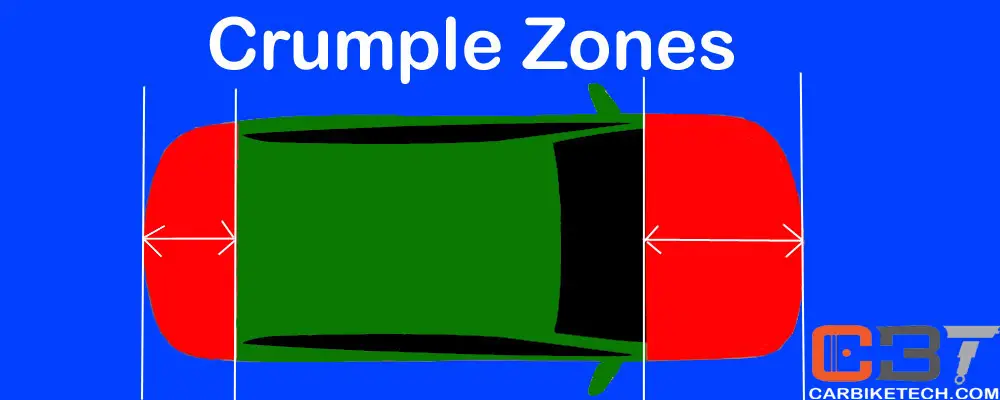What is a Crumple Zone or Crash Zone?
Nowadays, there are government regulations on making safe vehicles that can withstand the impact of a crash and reduce the severity of injuries to the occupants. So, manufacturers make vehicles as safe as possible. Manufacturers use safety features such as crumple zones or crash zones to reduce the impact of the crash. Crumple zones, crush zones or crash zones, are structural safety features used in vehicles, mainly in automobiles. These zones increase the time of the impact during a collision by controlling deformation. Thus, they reduce the effect of the impact or absorb the inertia forces as a result of the impact of a crash.

Purpose:
When a vehicle travels at speed, all of its contents, including passengers and luggage have inertia/momentum. It means that they would continue to move forward in the vehicle’s direction and also at its speed. In the event of sudden braking and/or stopping of a rigid framed vehicle, its contents would still continue to move forwards at their attained speed because of inertia. Since the vehicle body is not flexible, it can’t completely absorb the impact of collision. So, manufacturers provide crumple zones or crash zones in the vehicle body. The meaning of crumple is to bend or deform; and hence, the name.
When you apply to the brakes suddenly, the vehicle stops. However, its contents such as the passengers can’t stop immediately because of the inertia effect. So, they would, eventually, collide with the vehicle interior with the same force. However, the impact force multiplies many times their normal weight due to gravity. This is the precisely why manufacturers provide seat belts for all the passengers. The purpose of crumple zones is to slow down the collision impact. It also increases the time required for the occupants to decelerate. This reduces the peak force acting on the occupants over a given time. Crumple zones provide a kind of a buffer zone by absorbing the major part of impact of a collision.
Design:
Manufacturers design crumple zones to increase the time of the impact. These are the weakest sections of the vehicle body. These body sections are purposely made weak in order to absorb the impact of a collision. When a vehicle meets with an accident, the weak section crumples or bends quickly as opposed to the stronger section. Thus, it absorbs the impact and slows down and prevents it from being transmitted to the passenger cabin. Normally, crumple zones are located in the front part of a vehicle mainly to absorb the impact of a head-on collision. However, you may also find them on other parts of the vehicle.
According to studies, 65% collisions are front impacts, 25% rear impacts, 5% left side, and 5% right side. Manufacturers use aluminium, composite/carbon fibre honeycomb, or energy-absorbing foam in some racing cars that act as an impact reducer. It dissipates crash energy using a much smaller volume and lower weight than road car crumple zones. Some of the countries have also introduced impact attenuators in vehicles.
How Crumple Zones Work?
Crumple zones effectively absorb the impact energy and momentum in case of a crash or a collision. They increase the time over which the slowing of the occupants of the vehicle takes place. Besides, they also avoid intrusion of the impact into the passenger cabin. They prevent deformation of the passenger cabin to an extent. Thus, they protect the car occupants against injury in a much better way.

This is achieved by controlled weakening of outer parts of the vehicle’s body and chassis. They also strengthen and increase the rigidity of inner parts of the vehicle body. Vehicles are designed in such a way that they deform in some areas while keeping other areas intact during a crash. Engineers use more reinforced beams and higher strength steels while manufacturing the body shell. Using high strength materials transform the passenger cabin into a “safety cell”. Thus, impact energy that reaches the “safety cell” spreads over a wider area to reduce its deformation. Volvo provided side crumple zones with SIPS (Side Impact Protection System) in its cars in 1990s.
In conclusion, different crumple zones / crash zones makes vehicles safer and structurally stronger. They are the real life saving devices other than seat belts and air bags. Manufacturers routinely conduct crash tests to check the structural strength and effectiveness of crumple zones in their vehicles.
Image & Video Courtesy: Sydney Morning Herald
Watch crumple zones in action here:
Read More: What is ESP/ESC?>>
